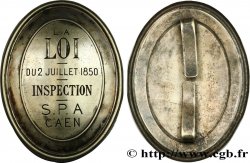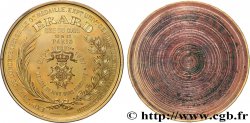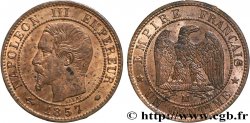fme_584070 - SECOND EMPIRE Médaille de l’annexion de la Savoie et de Nice à la France
Not available.
Item sold on our e-shop (2021)
Price : 150.00 €
Item sold on our e-shop (2021)
Price : 150.00 €
Type : Médaille de l’annexion de la Savoie et de Nice à la France
Date: 1860
Mint name / Town : France, Savoie / Nice
Metal : tin
Diameter : 50 mm
Orientation dies : 12 h.
Engraver CAQUÉ Armand Auguste (1795-1881)
Weight : 56,66 g.
Edge : lisse
Puncheon : sans poinçon
Coments on the condition:
Exemplaire ayant été légèrement nettoyé au droit. Reliefs nets
Catalogue references :
Obverse
Obverse legend : NAPOLEON III - EMPEREUR.
Obverse description : Tête laurée à gauche ; signé au-dessous CAQUÉ F..
Reverse
Reverse legend : ANNEXION DE LA SAVOIE ET DU COMTÉ DE NICE A LA FRANCE - 1860 // SAVOIE / VOTANT : 130.839. / SUFFRAGES : 130.533. / 22 ET 23 AVRIL / - / NICE / VOTANTS : 26.023. / SUFFRAGES : 25.648. / 15 ET 16 AVRIL /.
Reverse description : Légende en huit lignes ; signé : MASSONET ED..
Commentary
L'Annexion de la Savoie est le nom générique donné à la réunion, selon l’expression utilisée dans le traité de Turin, de l’ensemble de la Savoie (futurs départements de la Savoie et de la Haute-Savoie), correspondant au duché homonyme, et du comté de Nice, alors partie intégrante du royaume de Sardaigne, à la France en 1860. Bien que le pays fût occupé, voire annexé, à plusieurs reprises (par les Français : 1556-1559 ; 1600-1601 ; 1689 puis 1703-1713 ; par les Espagnols 1742-1749 ; à nouveau par la France durant la Révolution de 1792 à 1814), l’expression renvoie à la clause de « réunion » prévue par l'Article premier du traité de Turin du 24 mars 1860.
Le plébiscite se déroule les 22 et 23 avril 1860 : c'est la première élection au suffrage universel en Savoie, et les électeurs doivent répondre à la question « La Savoie veut-elle être réunie à la France ? ». « Pour Napoléon III, il ne s'agit pas de demander l'avis des citoyens mais de démontrer que sa politique bénéficie d'un soutien populaire. Tout se trouve mis en œuvre pour que les résultats du vote répondent aux attentes de l'Empereur » explique un historien. Les conditions de vote ne permettraient pas de caractériser aujourd'hui le vote de totalement démocratique ; « Les urnes étaient aux mains des mêmes autorités qui avaient issues les proclamations. Les contrôles étaient impossibles », les églises chantent la messe et le "Domine salvum fac Imperatorem" (Seigneur protège l'empereur). Bien que le travail des conservateurs fut très important, pour l'historien Paul Guichonnet, l'Annexion est « l’œuvre avant tout du clergé ». Le docteur Truchet d'Annecy commentait ainsi cette période « Si les six cents curés savoyards eussent fait opposition à l'annexion, la presque unanimité eût été en sens inverse, soyez-en bien sûrs ». Guichonnet souligne d'ailleurs que cette orientation du clergé savoyard s'est faite «contre l’orientation laïque et pro-italienne de Cavour, par l’aristocratie et le clergé, encadrant des masses rurales sans éducation politique».
Le plébiscite se déroule les 22 et 23 avril 1860 : c'est la première élection au suffrage universel en Savoie, et les électeurs doivent répondre à la question « La Savoie veut-elle être réunie à la France ? ». « Pour Napoléon III, il ne s'agit pas de demander l'avis des citoyens mais de démontrer que sa politique bénéficie d'un soutien populaire. Tout se trouve mis en œuvre pour que les résultats du vote répondent aux attentes de l'Empereur » explique un historien. Les conditions de vote ne permettraient pas de caractériser aujourd'hui le vote de totalement démocratique ; « Les urnes étaient aux mains des mêmes autorités qui avaient issues les proclamations. Les contrôles étaient impossibles », les églises chantent la messe et le "Domine salvum fac Imperatorem" (Seigneur protège l'empereur). Bien que le travail des conservateurs fut très important, pour l'historien Paul Guichonnet, l'Annexion est « l’œuvre avant tout du clergé ». Le docteur Truchet d'Annecy commentait ainsi cette période « Si les six cents curés savoyards eussent fait opposition à l'annexion, la presque unanimité eût été en sens inverse, soyez-en bien sûrs ». Guichonnet souligne d'ailleurs que cette orientation du clergé savoyard s'est faite «contre l’orientation laïque et pro-italienne de Cavour, par l’aristocratie et le clergé, encadrant des masses rurales sans éducation politique».








 Report a mistake
Report a mistake Print the page
Print the page Share my selection
Share my selection Ask a question
Ask a question Consign / sell
Consign / sell
 Full data
Full data



